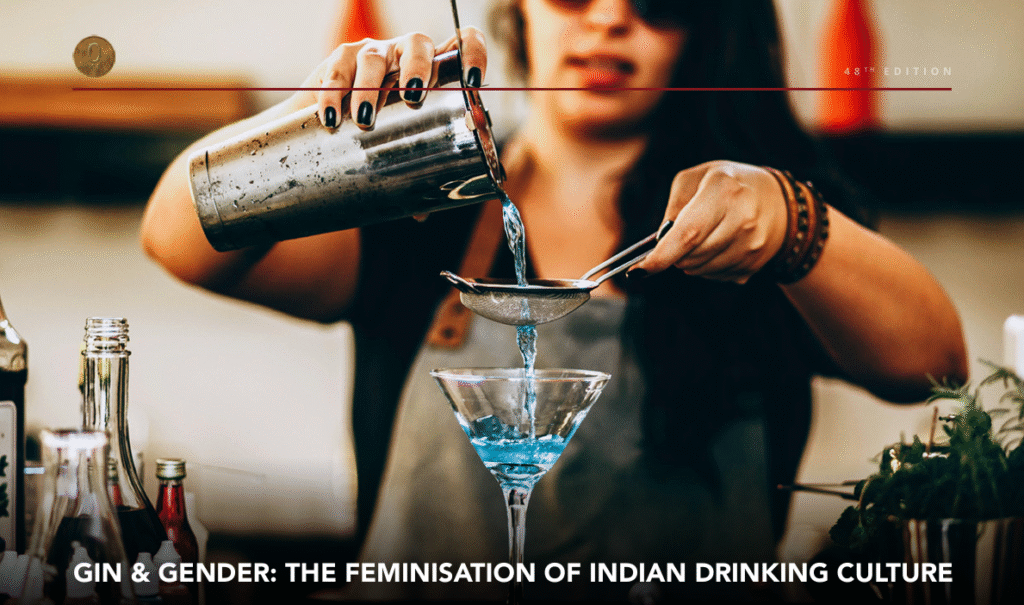GIN & GENDER – THE FEMINISATION OF INDIAN DRINKING CULTURE
Why so many women identify with gin today light, botanical, mixable, elegant, and how it plays into a subtle social shift in India’s urban drinking culture. Mansi Kotecha Guest Writer Gin greets you differently from other spirits. It doesn’t wrap you in warmth or weigh you down; it lifts, lingers, and leaves a trace of something you can’t quite name. A well-made gin and tonic feels like open air in a glass, bright, layered, a little mischievous.In recent years, I’ve noticed more women claiming that glass as their own. Not because gin is gentle, but because it’s versatile, shaped as much by who’s drinking it as by the botanicals in the bottle. In India’s evolving drinking culture, that matters. Gin doesn’t ask you to fit into a mould; it shifts with you, lets you set the tone. It’s a spirit that can whisper or sing, but either way, it never loses its composure. The Rise of Gin Among Indian Women I can’t pinpoint the exact moment it began, but somewhere between the bar takeovers I attended in Mumbai and the gin cocktails I sipped in Rajasthan and Delhi during work trips, I realised something had shifted. The tables that once held tumblers of whisky or tall vodka sodas were now dotted with slender glasses, condensation sliding down, a slice of grapefruit or a sprig of rosemary catching the light. The tables that once held tumblers of whisky or tall vodka sodas were now dotted with slender glasses, condensation sliding down, a slice of grapefruit or a sprig of rosemary catching the light. For me, gin came later. I had spent years with beers and wines, but gin was never part of my world, until one day, I ordered it on a whim. The first sip caught me off guard: bright, layered, and alive. I was hooked. The tonic water brought an unexpected sense of familiarity; growing up in Tanzania, tonic water was something we drank as medicine, its bitterness softened with the promise of health. Now, that same note carried a new meaning, still sharp, still memorable, but wrapped in something far more joyful. Whisky carries heritage; it comes with a certain gravitas, a story already written before you take your first sip. Vodka offers anonymity, being clean, adaptable, but often without a distinct voice of its own. Gin sits somewhere else entirely. It is expressive yet flexible, refined yet playful. It can feel like an afternoon in the garden or a night in the city, shaped entirely by the botanicals in the glass and the mood of the person holding it. In India’s evolving drinking culture, that freedom is quietly radical. Botanicals, Branding & the Language of Taste Gin speaks in aromas first. Before a drop touches the tongue, there’s the inhale: juniper edged with citrus, a whisper of spice, and the faint green of herbs. For many women, that moment is as much a part of the experience as the drink itself. It’s not only about alcohol; it’s about beauty, ritual, and mood. Indian gin makers have understood this and woven our own vocabulary into the spirit. Stranger & Sons nods to our spice cupboards with pepper, mace, and coriander seed. Hapusa reaches for the Himalayan forests, grounding its gin with wild juniper and fragrant cardamom. Pumori from Goa blends rosemary, vanilla, and cinnamon with Indian citrus, creating a gin that feels both coastal and cosmopolitan. These botanicals flavour a drink, and they anchor it emotionally. A sip becomes a memory trigger with kitchens warm with cardamom, gardens heavy with basil, summers bright with citrus. In a way, Indian gin doesn’t just taste familiar, it feels personal, and that is where its quiet power lies. Gin in Feminine Spaces I’ve seen gin show up differently depending on the room. At women-led brunches, it’s often the first drink on the table, bright, photogenic, and light enough to sip while conversations meander from work to travel to life’s quiet victories. At women-only tastings, the energy shifts again: curiosity takes over. People linger over aromas, debate the merits of tonic versus soda, and trade garnish secrets like family recipes. Gin works well here because it isn’t a drink that demands dominance; it invites participation. You can talk about it without sounding like you’re reciting a manual. You can customise it by adding a sprig of mint, a slice of orange, a shard of ice that melts slowly, and it becomes yours. In these spaces, the focus isn’t intoxication but connection. Gin has become the punctuation mark in conversations, soft enough not to interrupt, vivid enough to remember. Breaking the Binary For a long time, women’s drinking choices in India existed on a quiet spectrum – sweet cocktails and wine at one end, straight whisky or rum at the other. Choosing the ‘wrong’ end meant inviting judgment: too soft and you weren’t serious, too strong and you were “trying to be one of the boys.” Gin slipped through that gap almost unnoticed. It didn’t demand that you prove yourself, nor did it pat you on the head for playing safe. It could be crisp and sharp one night, floral and playful the next. It lets you call the shots, literally, on how it should be served. Older generations saw alcohol as something to be approached with caution, a marker of special occasions or male domains. Today, gin lives in everyday moments without needing permission. It’s elegant without being fragile, expressive without being loud, a spirit that, in its own quiet way, rewrites the rules. Feminine or Feminist? The rise of gin among Indian women isn’t just about what’s in the glass; it’s about what it signals. For too long, the spirits world was a man’s domain: men behind the bar, men distilling the bottles, men deciding what counted as ‘serious’ drinking. Women were expected to stay on the sidelines, order something light, sweet, or nothing at all. But gin has opened another path. Women now distil their own gins, lead bar
GIN & GENDER – THE FEMINISATION OF INDIAN DRINKING CULTURE Read More »










